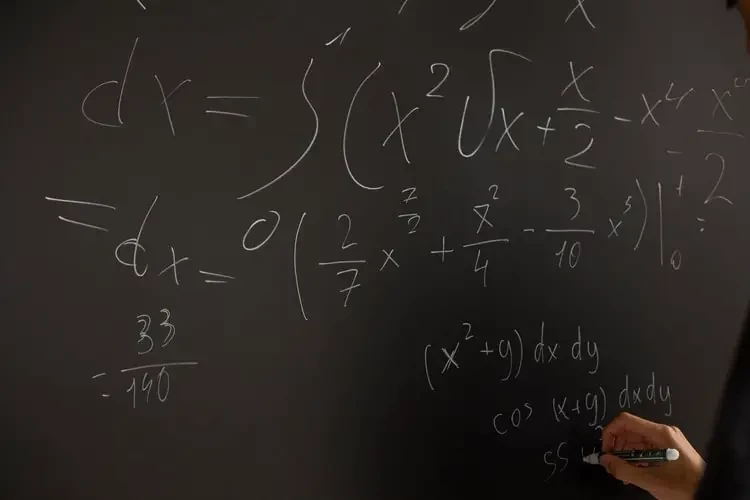Definition of Integration by Parts:
In integration by parts we have two functions of the same variable which are multiplied together. If we have the first function of x other function will also be an x. If the first integration function is y, the second function will also be y etc.
Integration by Parts formula:
Integration by parts formula helps us to multiply integrals of the same variables.
$∫udv = ∫uv -vdu$
Let's understand this integration by-parts formula with an example:
What we will do is to write the first function as it is and multiply it by the 2nd function. We will subtract the derivative of the first function and multiply by the integral of the 2nd function.

How to do Integration by Parts?
Doing integration by parts is super easy if we stick to the basics. In the examples below, we will do integration by parts in dividing an equation into 2 parts. The first part will be u and the next part will be DV.
Exponential Integral
Here suppose we're integrating x times e to the negative x.
$ \int xe^{-x} \; dx$
It is a rule of thumb to take the derivative first. By taking the derivative first, it becomes simple and easy for us to do integration by parts but it doesn’t always work right.
We will pick x in the equation to get 1 by taking the du of the derivative. We will not pick e because it will give us a negative value and thus it would’ve been difficult to deal with it. So picking the negative e of the dx will be dv in this example.
Now u is equal to x and dv is equal to e-x.
i.e.
$u = x$
$dv = e^{-x}$
$ \int u \; dv \;=\; \int xe^{-x} \; dx$
Now we will solve the dv part first. To get the value of d, we will take the derivative of the u and it will give us 1 dx. To get the value of v, we will need to integrate e-x.
Since, u = x
$du = dx$
Similarly,
$v = -e^{-x}$
$dv = e^{-x}$
By doing the above calculations we now have udu and vdv. It means u is x times v (so we’ll pull the negative out front e to the negative x).
Now we will subtract v, which is also negative e-x. So (we’ll pull the negative out front and make it positive).
This work will make us track the du which is the term dx.
$ \int xe^{-x} \; dx \;=\; -xe^{-x} \;+\; \int e^{-x} \; dx $
Now if we finish off this integration by parts, we’ve got -xe-x to the -x. And the -e-x and the constant.
$ -xe^{-x} \;+\; \int e^{-x} \; dx \;=\; -xe^{-x} \;-\; e^{-x} \;+\; c$
and we have now used integration by parts to calculate the integral of xe-x and + C.
You can further use integral by parts calculator for solving it online.
So let's do another example to solve integration by parts:
Logarithmic Integral
Suppose we want to integrate plain old natural logarithm of xdx.
$ \int lnx \; dx$
If we have a nice function like x, it will help us to solve integration by parts most of the time.
In this equation we don’t have a lot of values so let’s throw 1 and now we can see two different things floating around.
$ \int lnx . 1dx$
So now we will make u equal to the lnx term. As dv is going to be the 1 dx term. It will look like that.
Here,
$u = \ln(x),\quad dv = 1dx$
$ \int u \; dv \;=\; \int lnx . 1dx $
Now we will make u equal to lnx. The dv term is going to be 1dx so we will take a derivative. That is what the d tells us to do as well get 1xdx when we take the derivative of lnx. If we integrate v well, the integral of 1 is plain x.
Since, u = ln(x)
$du = \frac{1}{x} dx$
Similarly, v = x
$dv = dx$
Now we will use the UV - VDU formula, now we will get:
$ \int lnx . 1dx \;=\; x \; ln(x) - \int x \frac{1}{x} \; dx$
When you're doing integration by parts, the new integral we have is easier to evaluate. Or at least it should be more simplified than what you started with. If these two things are not the same, that either means you have picked the wrong u in the wrong dv. You should switch those or you shouldn't be doing integration by parts on this problem at all.
By doing the integration by parts, the integration solution will be:
$ \int lnx . 1dx \;=\; x \; ln(x) - \int x \frac{1}{x} \; dx$
$ \int lnx . 1dx \;=\; x \; ln(x) - \int 1dx$
$ \int lnx . 1dx \;=\; x \; ln(x) \;-\; x \;+\; c$
and I've now used integration by parts to find the antiderivative of lnx.
Algebric Integral
So let's do another example that follows this pattern. Suppose we're integrating x times the exponential function v raised to the X.
$ \int x . 5^x \;dx$
So in this case we will again pick plain x for dv to be the rest of the stuff 5x raised to the dx.
Here,
$u = x$
$dv = 5x dx$
A lot of times it seems the way the equation is, the first thing to pick is the u term. But most of the time it's not the case as you could write 5x times x and then that wouldn't be the case.
So it says that u=x. The derivative of that is 1dx. Let’s make dv equal to 5 to the x. Remember if you integrate 5 to the X to get v back, you actually get 5 to the x over the natural logarithm of 5.
Since, u = x
$du = 1 dx$
Similarly,
$v = \frac{5x}{\ln 5}$
$dv = 5x$
You can also look at the integration by parts formula to solve that. By following that formula, we will solve it as uv-vdu.
The formula says u=x and v=5x /ln5 . Now we need to subtract the integral as per the formula of vdu. We have 5x /ln5 . But, v and du is 1 dx.
$ \int x . 5^x \;dx \;=\; x \left( \frac{5^x}{ln(5)} \right) \;-\; \int \frac {5^x}{ln(5)} \; dx$
So let's analyze whether this part is better than what we started with? The answer is definitely going to be yes as we could pull the natural log as the constant.
$ \int x . 5^x \;dx \;=\; x \left( \frac{5^x}{ln(5)} \right) \;-\; \frac{1}{ln(5)} \int 5^x \; dx $
No we only have ∫5x dx. This is why we integrated to get the v term in the first place. So it says that we have,
$ \int x . 5^x \;dx \;=\; x \left( \frac{5^x}{ln(5)} \right) \;-\; \frac{1}{ln(5)} \frac{5^x}{ln(5)} \;+\; c$
You can also rewrite it is this way
$ \int x . 5^x \;dx \;=\; \left( \frac{x.5^x}{ln5} \right) \;-\; \frac{5^x}{(ln5)^2} \;+\; c $
and again there is our antiderivative of x times 5 raised to the x. This is how we solve integration by parts.
We hope this article helped you to understand what integration by parts means. How to understand the integration by parts formula and how to do integration by parts.
